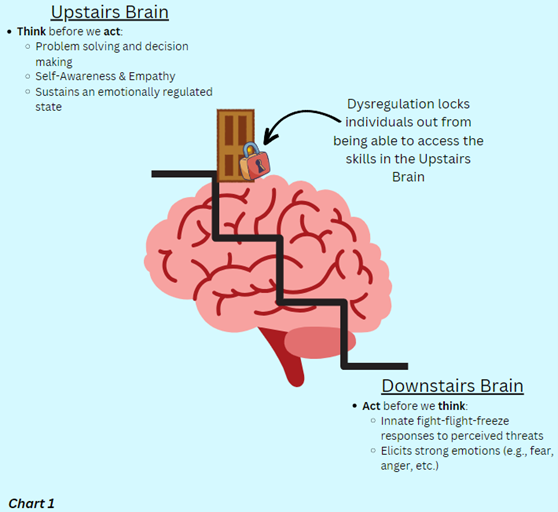By Katelyn Bentel, MSW, LSW
Social Worker at Easterseals DuPage & Fox Valley
Mental health is at the core of human interaction and is the foundation from which individuals navigate their world. Mental health can be difficult to understand because it does not manifest in the same way across the human population—let alone in an individual on a day-to-day basis. We all respond differently!
In healthy individuals, the upstairs brain (prefrontal cortex) is fully developed by the age of 25. This part of the brain is responsible for executive functioning skills (e.g., decision-making/impulse control, problem-solving, working memory, attention, emotional regulation, etc.). With this, adults possess an ability to discern emotions and process their own mental distress through self-reflection, which can potentially lead to them seeking out additional support—if deemed necessary.
Children instinctually operate from their downstairs brain (cerebellum, brainstem, and limbic system); responsible for basic, life-sustaining processes (e.g., breathing) and the fight-flight-freeze response in moments of perceived stress/danger. Their ability to identify, understand, and control their emotions is limited due to an underdeveloped upstairs brain, making it difficult to monitor and communicate struggles with their own mental health, thus, emphasizing the need for extra support.
Signs that your child may need additional support:
- Aggression/increased fighting
- Increased emotional sensitivity
- Frequent temper tantrums/uncharacteristic mood swings
- Stomachaches, headaches, physical complaints
- Loss of interest in previously enjoyed activities/self-isolation
- Inattentiveness
- Difficulty separating from caregivers
- Noticeable change in appetite
- Noticeable decrease in sleep quality
- Lack of self-confidence
These signs can temporarily appear during a child’s typical developmental process as they learn to adjust to inevitable stressors in their environment. However, these signs can also evolve into maladaptive coping skills—negatively impacting the child’s overall mental health. It is important to take notice of the presence of these signs, their frequency, duration, and impact on the child’s ability to function daily.
Understanding why your child is responding this way
Sometimes a child’s response to stress is misinterpreted as “bad behaviors.” A healthier and more sensitive way to interpret these responses is to reframe “bad behaviors” as communication in an attempt to express an unmet need.
For example, a child may be acting in ways that appear “attention-seeking” (e.g., whining/crying, temper tantrums, wanting help with simple tasks, etc.) when, in reality, they are having difficulty communicating that they are trying to seek out connection.
How to respond with Connection:
- Nurturance
· Respect and acknowledge child’s feelings
· Talk and act so child feels seen and safe
· Be Gentle
· Offer affection (verbal or physical)
· Encourage!
· Allow for mistakes
· Be consistent with developmentally appropriate rules and expectations - Validation of emotion
· Respect and acknowledge child’s feelings - Shared quality time with caregiver
· “Special Time,” just you and child
· Include child in your activities
· PLAY!
Another example of a misinterpretation is when a child is viewed as “manipulative” while, in reality, the child could be acting in ways that give them some semblance of control. Children are reliant on their caregivers to have their needs met. This has the potential to come with the repercussion of the child feeling as though they have lost their voice when (well-intentioned) decisions are made on their behalf by caregivers.
This lost voice may make a child feel uneasy, urging them to act in maladaptive ways as a coping mechanism to satisfy that lack of a sense of control. A simple way to instill a child’s sense of control is by offering the child options to choose from to complete the caregiver’s desired task/end goal. These examples are not to be confused as excuses for a child’s behavior or to invalidate a caregiver’s frustration, but rather, to serve as a potential explanation and encourage caregivers to pause and be curious about the why behind these actions. (Chart 2)
Seeking Additional Support
Seeking additional mental health support from a professional is a great use of resources if these dysfunctional responses/signs become a consistent presence in a child’s everyday life. Everyone can benefit from support. For instance, if an individual is recovering from a weakened ankle from a sports injury, it is common to receive physical therapy to rebuild that muscle. We should do the same for someone struggling with emotions/adapting to stressors.
There is no better time to create a strong foundation for mental health and foster resilience than during childhood. The Mental Health & Family Support Team at Easterseals DuPage & Fox Valley provides a safe and inclusive space for children and their families to receive support. Learn more about our mental health services here.






